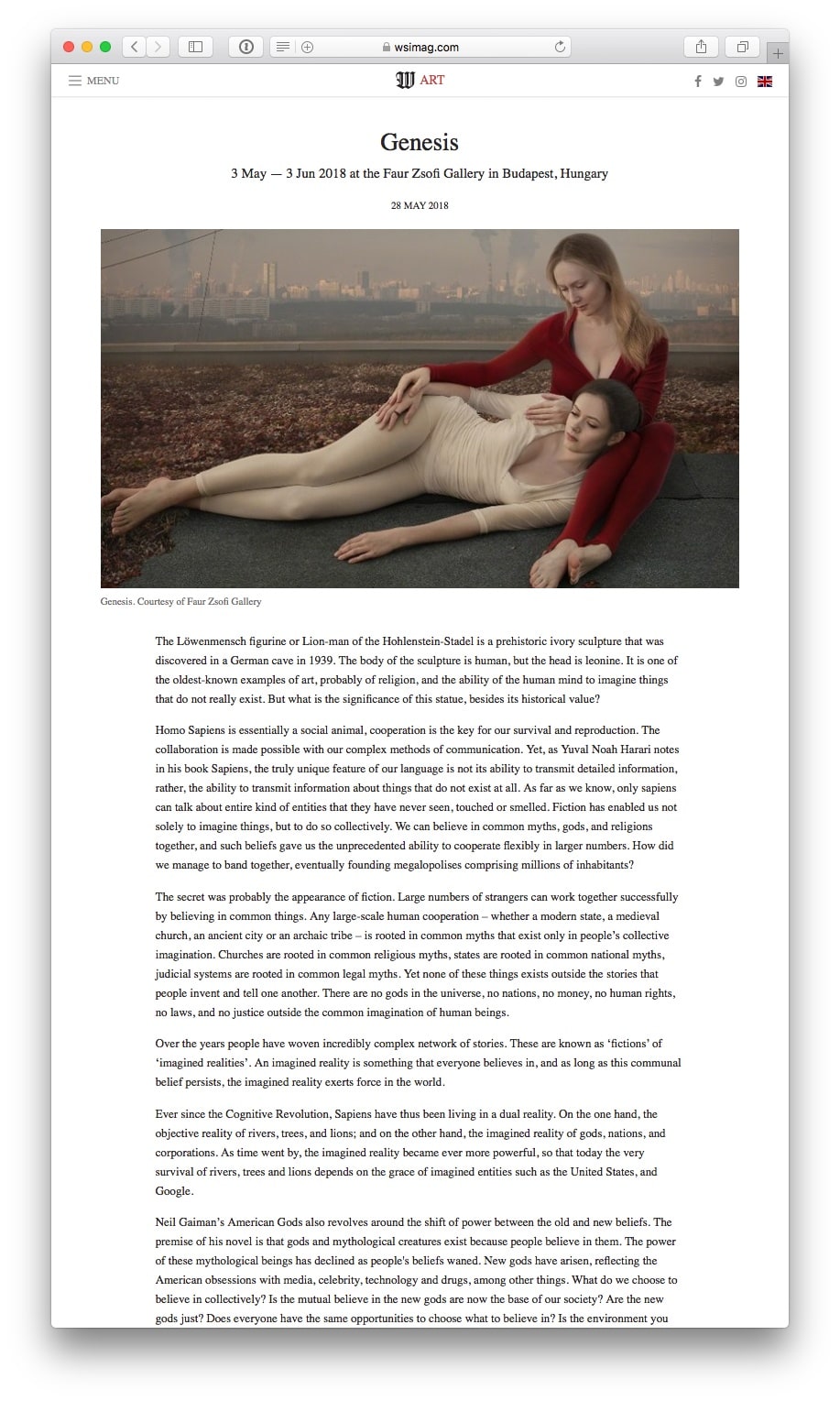3 May – 3 Jun 2018 at the Faur Zsofi Gallery in Budapest, Hungary
The Löwenmensch figurine or Lion-man of the Hohlenstein-Stadel is a prehistoric ivory sculpture that was discovered in a German cave in 1939. The body of the sculpture is human, but the head is leonine. It is one of the oldest-known examples of art, probably of religion, and the ability of the human mind to imagine things that do not really exist. But what is the significance of this statue, besides its historical value?
Homo Sapiens is essentially a social animal, cooperation is the key for our survival and reproduction. The collaboration is made possible with our complex methods of communication. Yet, as Yuval Noah Harari notes in his book Sapiens, the truly unique feature of our language is not its ability to transmit detailed information, rather, the ability to transmit information about things that do not exist at all. As far as we know, only sapiens can talk about entire kind of entities that they have never seen, touched or smelled. Fiction has enabled us not solely to imagine things, but to do so collectively. We can believe in common myths, gods, and religions together, and such beliefs gave us the unprecedented ability to cooperate flexibly in larger numbers. How did we manage to band together, eventually founding megalopolises comprising millions of inhabitants?
The secret was probably the appearance of fiction. Large numbers of strangers can work together successfully by believing in common things. Any large-scale human cooperation – whether a modern state, a medieval church, an ancient city or an archaic tribe – is rooted in common myths that exist only in people’s collective imagination. Churches are rooted in common religious myths, states are rooted in common national myths, judicial systems are rooted in common legal myths. Yet none of these things exists outside the stories that people invent and tell one another. There are no gods in the universe, no nations, no money, no human rights, no laws, and no justice outside the common imagination of human beings.
Over the years people have woven incredibly complex network of stories. These are known as ‘fictions’ of ‘imagined realities’. An imagined reality is something that everyone believes in, and as long as this communal belief persists, the imagined reality exerts force in the world.
Ever since the Cognitive Revolution, Sapiens have thus been living in a dual reality. On the one hand, the objective reality of rivers, trees, and lions; and on the other hand, the imagined reality of gods, nations, and corporations. As time went by, the imagined reality became ever more powerful, so that today the very survival of rivers, trees and lions depends on the grace of imagined entities such as the United States, and Google.
Neil Gaiman’s American Gods also revolves around the shift of power between the old and new beliefs. The premise of his novel is that gods and mythological creatures exist because people believe in them. The power of these mythological beings has declined as people's beliefs waned. New gods have arisen, reflecting the American obsessions with media, celebrity, technology and drugs, among other things. What do we choose to believe in collectively? Is the mutual believe in the new gods are now the base of our society? Are the new gods just? Does everyone have the same opportunities to choose what to believe in? Is the environment you were born in to, the best place for you to flourish? Do we need to continuously reflect on our values to ensure our spiritual growth?
The exhibition tries to explore these questions by comparing two series Empty Spaces and Revival by Katerina Belkina, created during two periods of complete divergence in her career, and in her life. While Empty Spaces - created at the time when Katerina was still living in Moscow - focuses around the subjects of urbanism, capitalism and materialism, Revival – created during the time she moved to Berlin, and started her own family – is about the return to the spiritual.
“The 21st century is the century of loss of faith. The borders of right and wrong are blurred, prosperity ruins spirituality. People have only recently started to live in comfort; the task now is to learn to combine physical comfort with the development of our soul. It is hard. Somewhere there was a gap between the religious period and pop culture. Yet, faith is such a vital need of our psyche that people look for its new incarnations, or try to transform the existing ones. And since these searches occur from time to time, this leads to a cyclical repetition. If Renaissance is an escape from the influence of the Church to the exploration of identity and the living material world, Revival is an escape from consumerism and materialism, imposed by society, to the exploration of oneself and personal spiritual growth. Neorenaissance in everyday life.”
Genesis is a juxtaposition between two parts of life. One is a path of a material self, praising material possessions, stuck in a fast-paced environment of empty spaces. There is probably a time in life when you are trying to find a way out of the monotonic urban life, with underlining condemnation of capitalist and consumerist culture. From the society where one’s wealth is an indicator of one’s worth, where the workplace becomes a temple and material possessions became an undivided part of the self. It is easy to get lost in the polished and glossy illusion of the cities seduction, get lost in a need to fit, bend, bow and buy. The captivating, gloomy and, at first, submissive portrait figures in the series Empty Spaces are gaining more and more awareness of the hermetic plastic box they are seized in, and start looking for a home, a place to belong. Or they try to find another route.
The second path is of a spiritual self, seeking inner enrichment. A reflection about consciousness, comparing ideologies to the real self. Spirituality and materialism are two sides of a same coin. They both represents contrasting, but merging social concepts of modern human society. The series Revival is about denial of the material. As a part Neo-Renaissance, rebirth of nature, morality and the sacred, the works combine both classical painting techniques and refined digital techniques. Characters of Revival are searching a way out, by looking inside. They ask for a redemption by diving deeper inwards in a metamorphosis of spiritual growth. Moving outside the box is a necessity, however the true escape for Katerina was found after settling in, giving birth to a new life. People who are unsatisfied with their environment always think of moving as the first option, but is it the best one?

